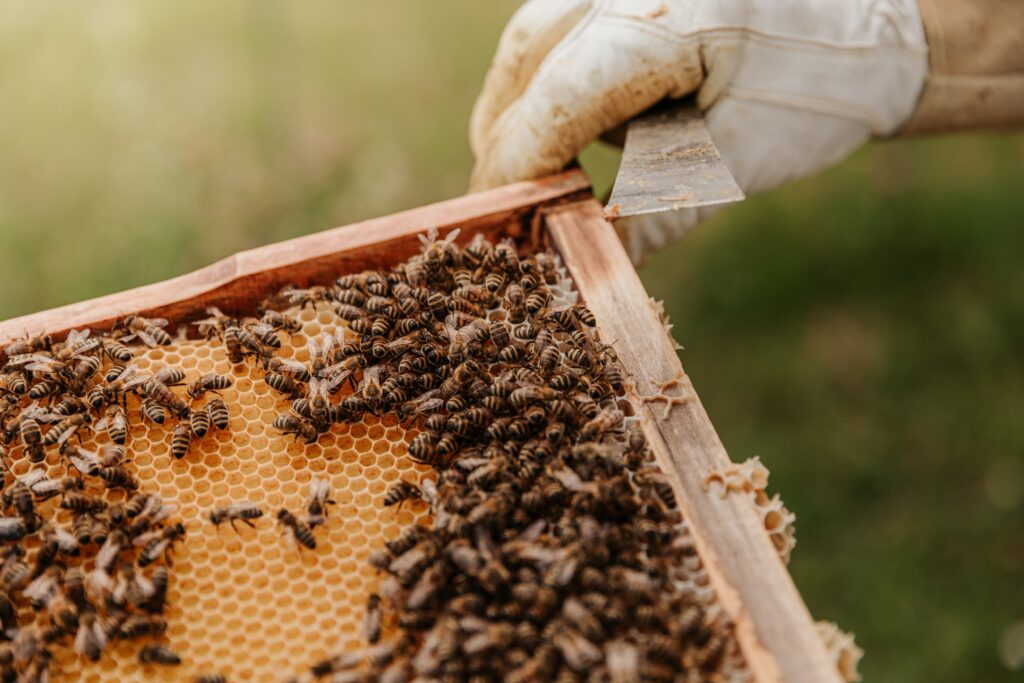When people think of bees, most of them think of the fuzzy flower-loving bumblebee or the western honeybee, the iconic black and yellow insect that makes honey. These are just two of more than 800 bee species—domesticated and wild—that are vital to Canada’s ecosystems and that commercial farmers rely on to pollinate their crops.
It should be news to no one that pollinators of all kinds are struggling. Climate change and parasitic mites have contributed to the deaths of countless domesticated bees in recent years, while pesticides and habitat loss threaten thousands of wild pollinator species—bees, as well as beetles and butterflies. But here’s the good news. In Canada, there are individuals and groups keeping busy to sustain these tiny ecological superheroes and spread public awareness of the many ways we rely on them. Each spring, in Alberta and Manitoba, semi-trucks haul some 60,000 bee colonies (that’s up to 3.6 billion bees) across the Prairies to pollinate millions of acres of yellow canola flowers. The colonies are rented out to farmers by commercial beekeepers who then sell the honey that is produced as a by-product.
“Bees perform an essential function in the food system,” says Rod Scarlett, executive director of the non-profit Canadian Honey Council. These minuscule workers are an integral part of modern industrial agriculture, he notes. When their summer’s work is done, the bees are trucked home and beekeepers either wrap up the hives or move them into barns, where the insects can safely spend the winter. But domestic bees are just one part of the equation. Canadian farms depend on a range of pollinators, including insects, birds, bats and other animals for many of the foods we consume. “Some plants have a desire for different types of pollinators, so it’s important that we also look to the ones in nature to help pollinate plants and flowers,” Scarlett adds. He encourages Canadians to support them by growing native pollinator-friendly plants, such as lavender and milkweed, in their backyards.
While domesticated and wild bees in Canada face various threats, it’s the wild bees that need our help the most, says Jason Gibbs, an associate professor in the University of Manitoba’s department of entomology. “They don’t have the benefit of a dedicated commercial industry to help maintain their populations, so they’re on their own.” Even with our help, there are misconceptions about how to sustain domesticated bee populations. Well-meaning amateurs who start beehives at home can unintentionally put native species at risk. Without knowledgeable, committed beekeepers, these small-scale hobby colonies can turn into reservoirs for diseases and pests, warns Gibbs. The University of Manitoba’s nine-week program—Beekeeping for the Hobbyist—is an excellent resource for would-be apiarists because it equips them with the tools to care for bees safely and responsibly.
At Living Sky Honey, in Kronau, a hamlet near Regina, expert beekeeper Louise Yates provides her bees with a diverse diet—wildflowers, spring-flowering fruit trees and shrubs including haskap, plums, currants, cherries and apples, all of which enhance the honey’s flavour profile. “Honey is a lot like wine,” notes Yates. “It has a terroir—or sense of place—and my honey will taste similar, yet different, from honey that is made even [just] 20 kilometres away.” Like most of her fellow apiarists (a.k.a. beekeepers), Yates delivers her honey to nearby communities and takes every opportunity to share her passion with her customers. “If you’re interested, every beekeeper will talk your ear off about bees and honey.” Buying locally made honey boosts our agriculture industry and supports our local beekeepers. To help protect wild pollinators, sometimes, less is more. Skip the pesticides and don’t aim for that perfectly green lawn—“a diversity wasteland,” says Gibbs. Instead, grow native pollinator-friendly flowers, which are easier to maintain anyway. And cross out raking on your fall task list. Dead leaves provide winter habitats for bees and butterflies.

AMA BUZZ
AMA is getting a million new members—and they’ll be living right at our centres! In June, we began installing beehives at select AMA locations to raise awareness about the importance of pollinators, which are responsible for one out of every three bites of food we eat. By the end of 2024, 20 hives will be in place, adding a million bees— roughly one for every AMA member. The buzzy initiative complements our commitment to planting 100 hectares of “forever forest” in Alberta by 2026—one hectare for every year AMA has been part of the province’s history. By ensuring the health and biodiversity of our forests, we’re helping to preserve and restore homes for all pollinators, including more than 370 species of bees native to Alberta. With this in mind, we also provided each of our AMA employees with a free willow tree—an early and important source of spring pollen—to plant at home. Because positive change begins in our own backyard.
